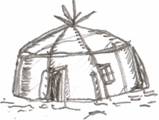
Yaranga
Encyclopedia

A Yaranga is a tent
Tent
A tent is a shelter consisting of sheets of fabric or other material draped over or attached to a frame of poles or attached to a supporting rope. While smaller tents may be free-standing or attached to the ground, large tents are usually anchored using guy ropes tied to stakes or tent pegs...
-like traditional mobile home of some nomad
Nomad
Nomadic people , commonly known as itinerants in modern-day contexts, are communities of people who move from one place to another, rather than settling permanently in one location. There are an estimated 30-40 million nomads in the world. Many cultures have traditionally been nomadic, but...
ic Northern indigenous peoples of Russia, such as Chukchi
Chukchi people
The Chukchi, or Chukchee , ) are an indigenous people inhabiting the Chukchi Peninsula and the shores of the Chukchi Sea and the Bering Sea region of the Arctic Ocean within the Russian Federation. They speak the Chukchi language...
and Siberian Yupik
Siberian Yupik
Siberian Yupiks, or Yuits, are indigenous people who reside along the coast of the Chukchi Peninsula in the far northeast of the Russian Federation and on St. Lawrence Island in Alaska. They speak Central Siberian Yupik , a Yupik language of the Eskimo–Aleut family of languages.They were also...
.
A Yaranga is a cone-shaped or rounded reindeer-hide tent. It is built of a light wooden frame covered with reindeer
Reindeer
The reindeer , also known as the caribou in North America, is a deer from the Arctic and Subarctic, including both resident and migratory populations. While overall widespread and numerous, some of its subspecies are rare and one has already gone extinct.Reindeer vary considerably in color and size...
skins or canvas sewn together.
The word yaranga comes from the Chukchi language
Chukchi language
The Chukchi language is a Palaeosiberian language spoken by Chukchi people in the easternmost extremity of Siberia, mainly in Chukotka Autonomous Okrug...
. In Russian use, the terms chum
Chum (tent)
A chum is a temporary dwelling used by the nomadic Yamal-Nenets and Khanty reindeer herders of northwestern Siberia of Russia. They are also used by the southernmost reindeer herders, of the Todzha region of the Republic of Tyva and their cross-border relatives in northern Mongolia...
, yurt
Yurt
A yurt is a portable, bent wood-framed dwelling structure traditionally used by Turkic nomads in the steppes of Central Asia. The structure comprises a crown or compression wheel usually steam bent, supported by roof ribs which are bent down at the end where they meet the lattice wall...
and yaranga may be used interchangeably.
Chukchi
It is built of a light wooden frame covered with reindeerReindeer
The reindeer , also known as the caribou in North America, is a deer from the Arctic and Subarctic, including both resident and migratory populations. While overall widespread and numerous, some of its subspecies are rare and one has already gone extinct.Reindeer vary considerably in color and size...
skins sewn together. A medium-size yaranga requires about 50 skins.
A large yaranga is hard to heat completely up. There is a smaller cabin called a polog built inside it, that can be kept warm and cosy.
Siberian Yupik
The most numerous of the Siberian YupikSiberian Yupik
Siberian Yupiks, or Yuits, are indigenous people who reside along the coast of the Chukchi Peninsula in the far northeast of the Russian Federation and on St. Lawrence Island in Alaska. They speak Central Siberian Yupik , a Yupik language of the Eskimo–Aleut family of languages.They were also...
peoples, the Chaplino Eskimos (Ungazigmit) had a round, dome-shaped building for winter. Literature refers to it as a "yaranga", the same term which the Chukchi people use, but the term used in the Chaplino Eskimos' language is mengteghaq (mɨŋtˈtɨʁaq, extended Cyrillic: мыңтыӷақ). Its framework was made of posts. Tarpaulin
Tarpaulin
A tarpaulin, colloquially tarp, is a large sheet of strong, flexible, water-resistant or waterproof material, often cloth such as canvas or polyester coated with urethane, or made of plastics such as polyethylene. In some places such as Australia, and in military slang, a tarp may be known as a...
s were used for covering the framework. The yaranga was surrounded by sod or planking around the base. There was a smaller cabin within the yaranga at the rear, used for sleeping and living. It was separated from the outer, cooler parts of the yaranga with haired reindeer skins and grass, supported by a cage-like framework. In the language of Chaplino Eskimos, it was called [aːɣra], a word borrowed from the Chukchi language
Chukchi language
The Chukchi language is a Palaeosiberian language spoken by Chukchi people in the easternmost extremity of Siberia, mainly in Chukotka Autonomous Okrug...
. Household duties were done in the larger outer room of the yaranga in front of this inner building. In winter storms, and also at night, the dogs were there. This room for economical purposes was called [naˈtɨk].
There were also other types of buildings among Chaplino Eskimos: [aːwχtaq] was a modernized type, and [pəˈlʲ̥uk] was used for summer.
Cyrillic
The transliteration of author's name, and the rendering of title in English:Siberian Yupik dwelling
Rendering in English: Ungazik settlement, KunstkameraKunstkamera
The Kunstkamera was the first museum in Russia. Established by Peter the Great and completed in 1727, the Kunstkammer Building hosts the Peter the Great Museum of Anthropology and Ethnography, with a collection of almost 2,000,000 items...
, Russian Academy of Sciences
Russian Academy of Sciences
The Russian Academy of Sciences consists of the national academy of Russia and a network of scientific research institutes from across the Russian Federation as well as auxiliary scientific and social units like libraries, publishers and hospitals....
. Old photos about former life of a Siberian Yupik settlement, including those of a various house types, both inside and outside.

